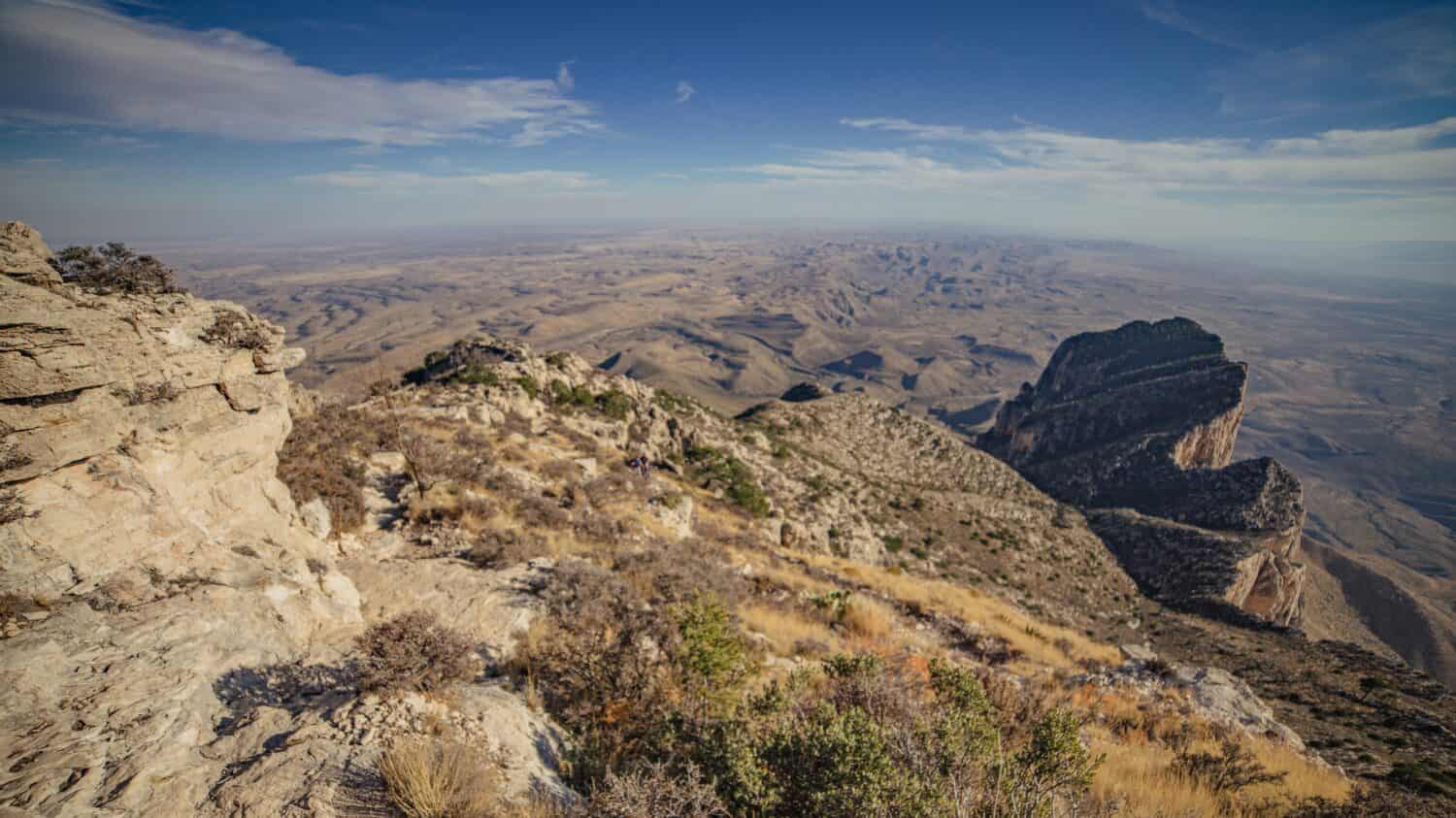Soaring above Texas at the dizzying height of 8,751 feet above sea level, Guadalupe Peak is the highest point in the entire state. Even more incredible is that it is over 8,000 feet higher than the lowest point in Texas in the Gulf of Mexico! Hiking to the summit of Guadalupe Peak is an 8.4-mile round trip that takes around 6 to 8 hours, with an incredible elevation gain of 3,000 feet.
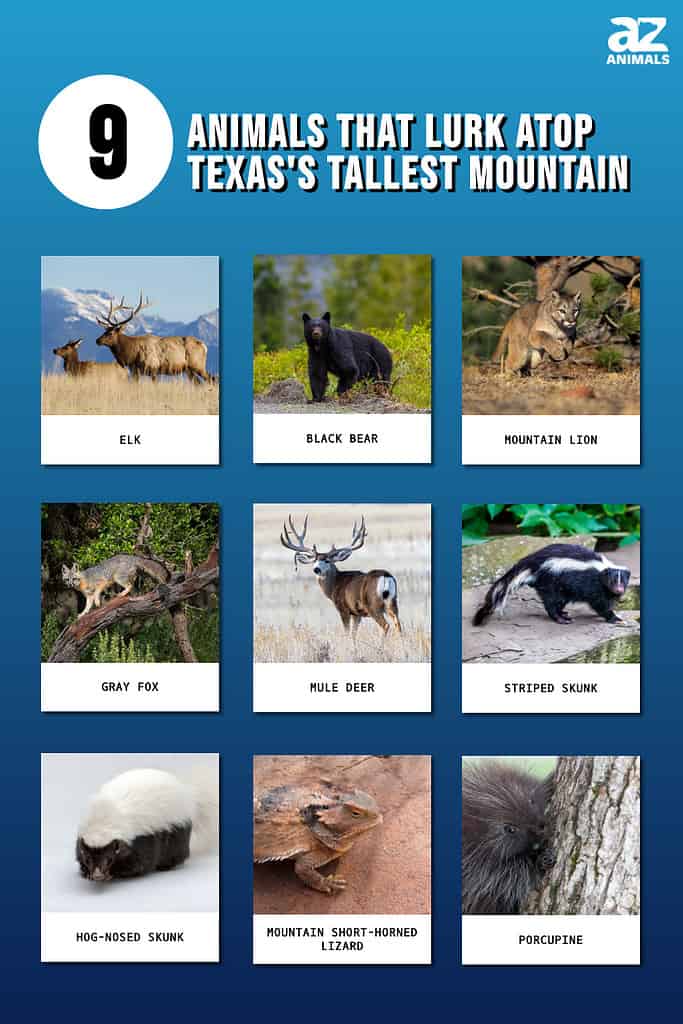
It’s quite a daunting trek up that mountain, but any who are brave enough to embark on the journey will discover a unique variety of diverse ecosystems and habitats along the way. At the base lies the Chihuahuan Desert, with animals like western diamondback rattlesnakes, collared lizards, coyotes, scorpions, and tarantulas. However, as you travel further up Guadalupe Peak, the landscape and ecosystems begin to change, as do the peak’s animal residents. Let’s take a closer look at nine of these incredible animals that make their homes on the tallest mountain in Texas!
1. Elk (Cervus canadensis)
Although elk were native animals in the Guadalupe Mountains, by the late 1800s they had all been hunted to extinction in this area. However, in 1928 a rancher named J.C. Hunter imported 44 elk from the Black Hills of South Dakota and released them in McKittrick Canyon. Today there are a few small herds that you can occasionally see on and near Guadalupe Peak.
Also known as wapiti, elk look like oversized deer and are one of the largest terrestrial animals in North America. Elk typically live along the edges of forests or in forest habitats where they eat bark, plants, grasses, and leaves. Even though they are enormous animals, elk are also surprisingly graceful creatures. Male elk can weigh between 400 and 1,000 pounds and sport large antlers.
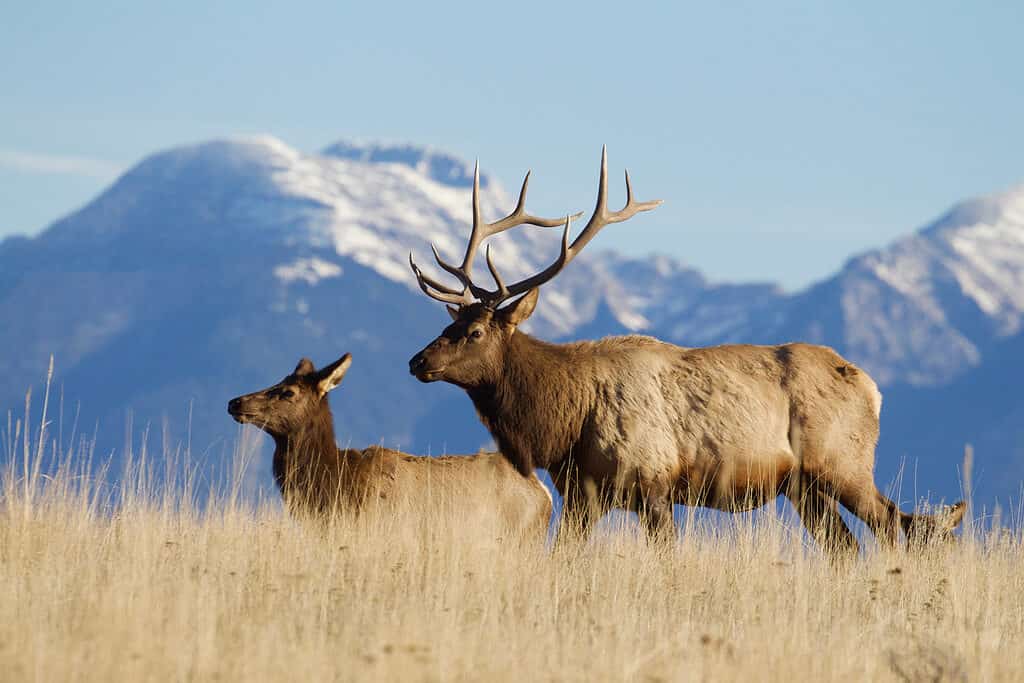
Male elk grow new antlers every spring and then shed them in the fall.
©Tom Reichner/Shutterstock.com
2. Black Bear (Ursus americanus)
Due to their shy and reclusive nature, the black bears living on Guadalupe Peak are rarely seen. Unlike many of their cousins, these elusive bears have adapted to the mild climate of the Guadalupe Mountains and forage for food throughout the year without hibernating. Black bears eat all kinds of different foods, from nuts to juicy berries, roots, insects, and small animals. Although you will likely not see a black bear in the Guadalupe Mountains wilderness areas, it is always best to be prepared and learn how to stay bear-safe during your adventures. And of course, if you are lucky enough to spot a black bear, be sure to leave it alone.
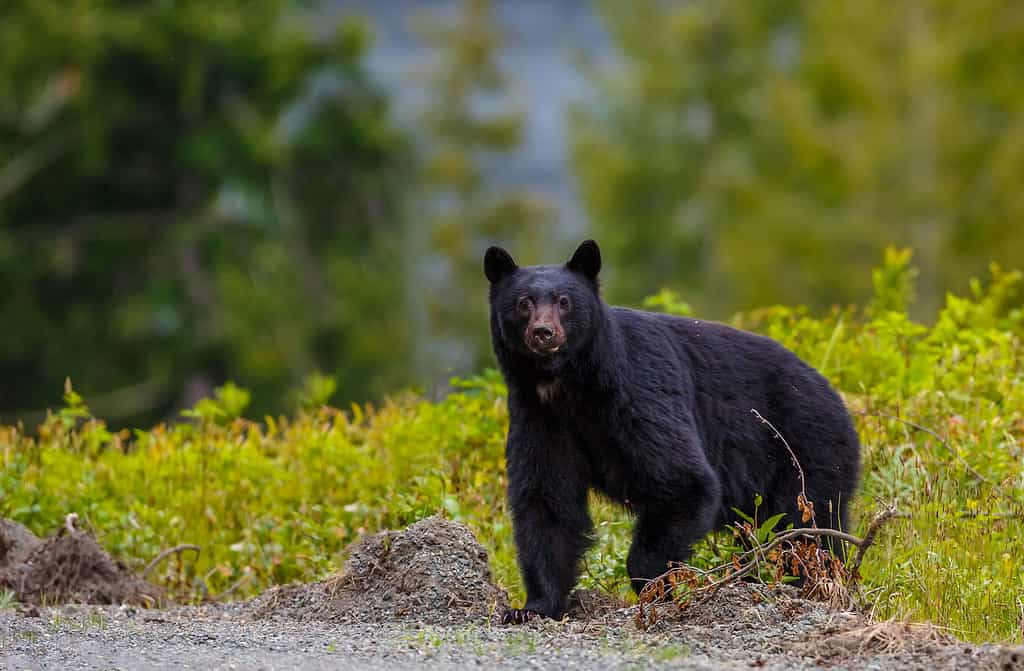
Black bears on Guadalupe Peak are unique in that they don’t hibernate.
©Menno Schaefer/Shutterstock.com
3. Mountain Lion (Puma concolor)
Another elusive animal that lurks atop Texas’ tallest mountain is the mountain lion or cougar. These large and majestic big cats are highly adaptable and versatile. They are capable of thriving in a wide variety of habitats, but they typically prefer dense underbrush and rugged rocky areas where they can utilize their impressive stealth. Mountain lions are most active at night and during twilight hours, but daytime sightings have been reported on rare occasions.
Mountain lions are very rare on Guadalupe Peak, and they do their best to avoid humans whenever possible. However, they are dangerous and powerful and could be aggressive toward a human if the conditions are right. This is most likely to happen if the mountain lion is a mother cat protecting her young, a juvenile cat who is still learning boundaries, or an injured or sick mountain lion. Just like with black bears, it is important to respect mountain lions on Guadalupe Peak and know how to keep yourself safe.
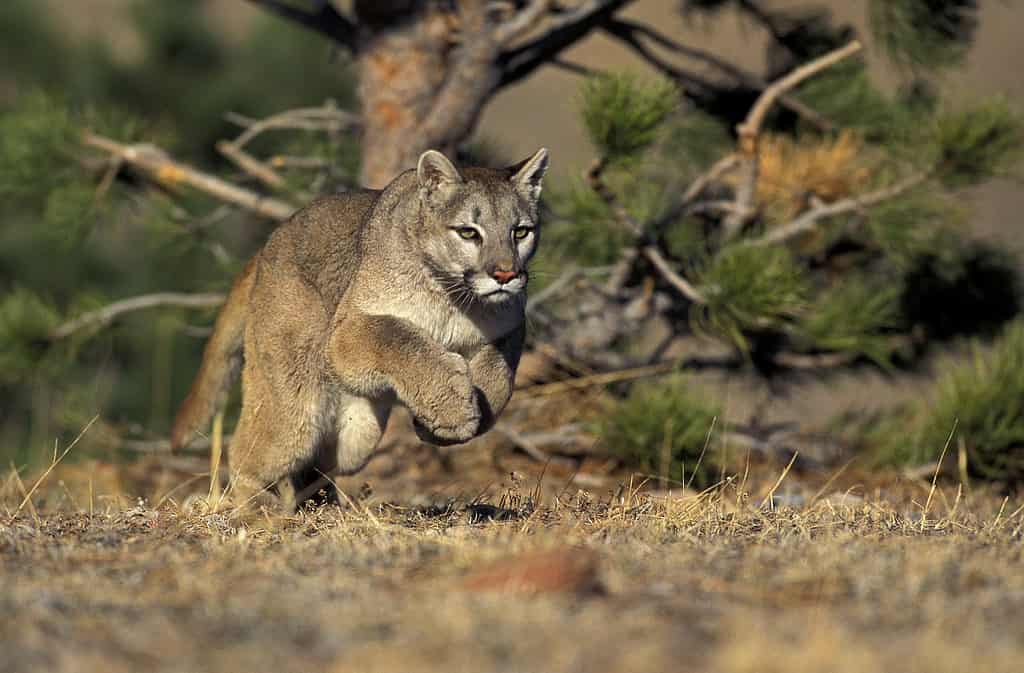
Mountain lions can run up to 50 mph in short bursts.
©iStock.com/slowmotiongli
4. Gray Fox (Urocyon cinereoargenteus)
Another animal that you might encounter on Texas’ tallest mountain is the gray fox. This striking animal has a grizzled coat with a black stripe running down to its tail, which also has a bold black tip. The fox’s belly and the back of its ears are a lighter color (often a warm brown hue). Even though it is a canid like a wolf or a dog, the gray fox has hooked claws that help it to climb trees in search of food and to escape predators. These skillful hunters are omnivorous and eat berries and other fruits as well as rodents, birds, small mammals, reptiles, and amphibians. Gray foxes are rather elusive during the day, but they are pretty active at dawn and dusk. In addition, they are generally shy around humans.
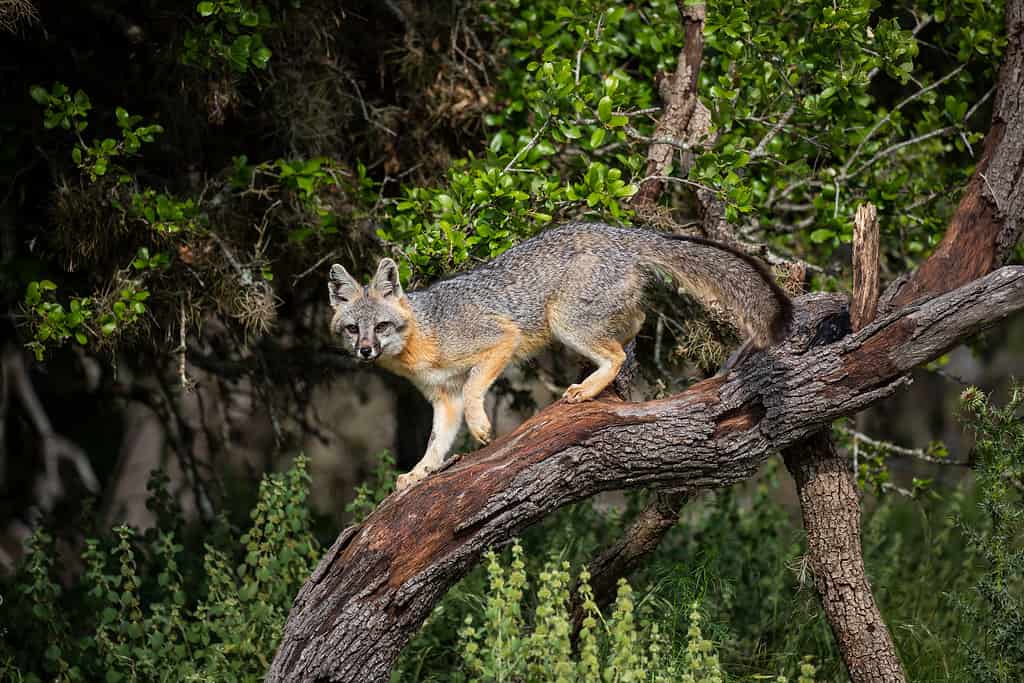
Gray foxes often live in canyons and forests.
©Danita Delimont/Shutterstock.com
5. Mule Deer (Odocoileus hemionus)
The most commonly seen animals on Texas’s tallest mountain are mule deer. They get their name from their large mule-like ears, which they can move independently of each other. Their large ears and keen senses give them the advantage of listening carefully for any signs of danger — an essential survival skill in the Guadalupe Mountains where mountain lions often stock them from the shadows. Mule deer have black-tipped tails and bifurcated antlers that fork as they grow each year. although They are more than capable of running, many times you’ll see mule deer simply trotting along, although they are always on the move. They also commonly stot or pronk — that is, they jump and land with four feet coming down together all at once.
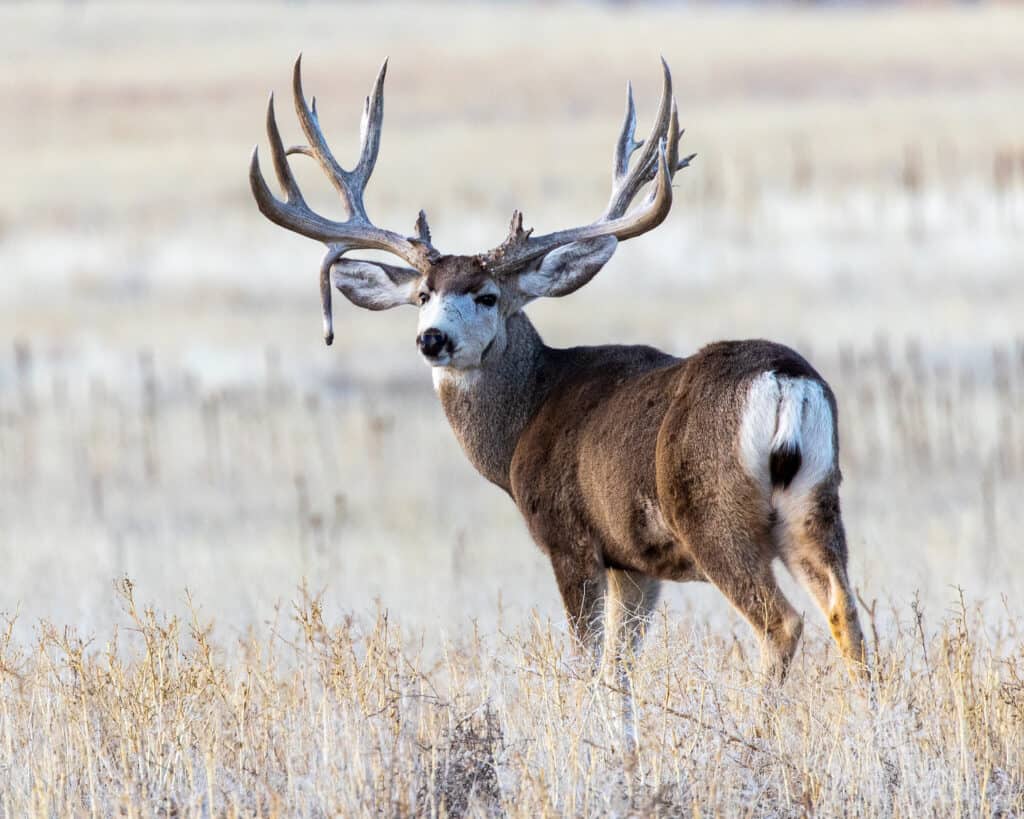
Mule deer may look a bit like white-tailed deer, but their tails have black tips instead of white.
©iStock.com/Jeff Edwards
6. Striped Skunk (Mephitis mephitis)
The striped skunk is the most common skunk species in North America and one of the many animals that live on Texas’s tallest mountain. This small and stout animal is a sturdy little creature with short legs, a cone-shaped head, and a large furry tail. The striped skunk has a very distinctive white stripe that starts at the top of its head, then splits at its neck and runs down either side of its body, almost like a racing stripe. You might only catch a glimpse of this elusive creature at night because it is mostly nocturnal. It is likely that you will smell one of these skunks long before you see one, since like all skunks, the striped skunk has two scent glands and can spray a very potent musk.

The amount of white in a striped skunk’s fur varies from skunk to skunk.
©iStock.com/Edwin_Butter
7. Hog-Nosed Skunk (Conepatus)
The second type of skunk that lives on Guadalupe Peak is the hog-nosed skunk, which is one of the largest skunk species in North America. Hog-nosed skunks get their name from their long snouts and distinctive hog-like noses. They use their uniquely shaped noses to root around in the earth for food, overturning debris and rocks much like pigs do. In addition, their front legs and shoulders are strong and muscular like a badger, with long, heavy claws on their front feet that are perfect for digging. These unique adaptations have led to the hog-nosed skunk also being referred to as the “rooter skunk” or the “badger skunk”. Hog-nosed skunks are not big fans of hot desert areas, choosing instead to live in partially forested foothills and mountains.

Hog-nosed skunks have one large white stripe that runs from the top of the head to the tip of their tail.
©iStock.com/Jay Pierstorff
8. Mountain Short-Horned Lizard (Phrynosoma hernandesi)
You may know this next animal as a horny toad or horned toad, but in reality, it’s not a toad at all! Its actual name is the greater short-horned lizard. These fascinating reptiles are usually 2 to 5 inches long, with squat flat bodies. They have very unique scales bordering the top of their heads like a crown. Mountain short-horned lizards can appear gray, reddish brown, or yellowish, and there are two rows of large dark spots or stripes running down their backs. Their colors actually intensify if they feel threatened or when they are aggressive. Like their name, these little horny lizards live in high elevations — like on Guadalupe Peak in Texas. They’re usually most active in the evening, but you might spot one sunning on a rock during the day.
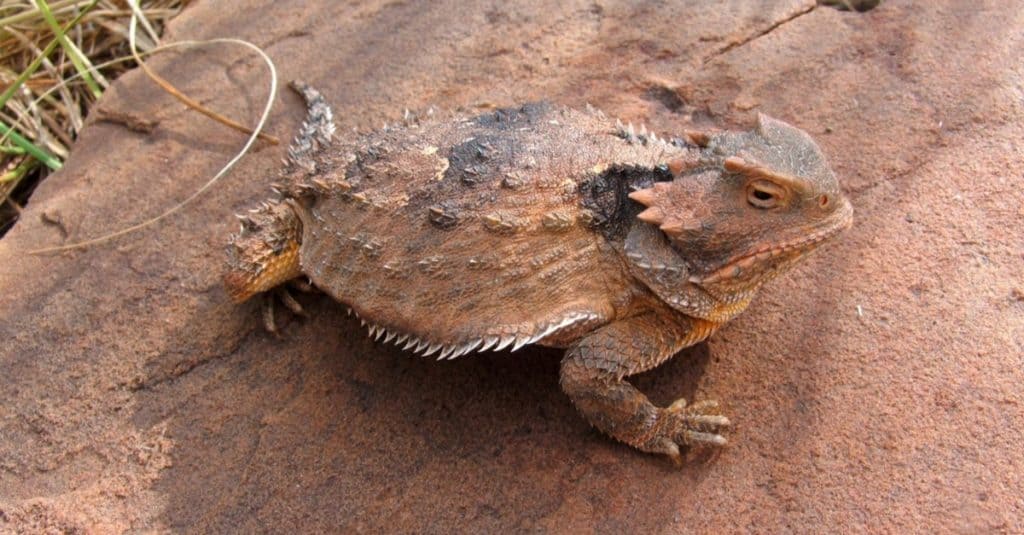
Greater mountain short-horned lizards are “sit-and-wait” predators who eat ants and grasshoppers.
©Matt Jeppson/Shutterstock.com
9. Porcupine (Erethizon dorsatum)
The second largest rodent species in North America is the North American porcupine, another unique animal that lives on Texas’s tallest mountain. Porcupines have a stocky build with short legs, a small face, and a short, thick tail. Their dark brown or black fur is accentuated by white highlights, and from head to tail they are around 2 to 4 feet long and weigh between 7.7 and 39.7 pounds. Their unique defense comes from over 30,000 quills that cover their entire body except for their feet, face, and underbelly. These large quills are actually modified hairs that have evolved into sharp and barbed spines, and they also help insulate their bodies during cold winter months.
Despite popular belief, porcupines do not shoot or throw their quills. However, they can detach their quills, and the barbs at the end can easily lodge into an attacker’s flesh if they come into contact. Porcupines are nocturnal and most active at night. They are also decent climbers and are often tempted by new growth high up in the trees.
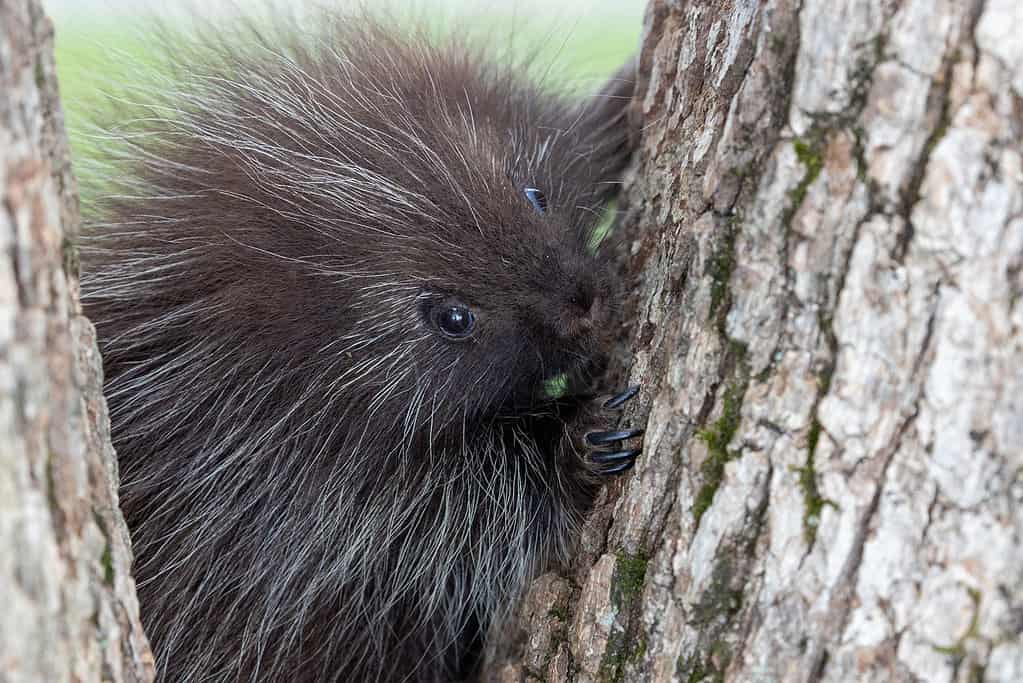
North American porcupines have antibiotics in their skin, in case they hurt themselves with their quills!
©iStock.com/Sandra Mitchell
Plants Living on the Tallest Mountain in Texas
At over 8,000 feet above sea level, Guadalupe Peak is the highest point in Texas. The surrounding desert landscape of the Salt Basin Dunes is filled with sagebrush and cactus, but if you lace up your hiking boots and trek up to the top of the peak (a six to eight hour round trip), you’ll be rewarded with an entirely different ecosystem.
Made up of limestone, Guadalupe Peak was once a thriving coral reef submerged in an ancient ocean. You’ll encounter all types of high desert flora and fauna during your hike, and maybe even an occasional fossil from this prehistoric reef. At the summit of Guadalupe Peak, you’ll discover a diverse ecosystem where weather conditions vary greatly. As you ascend to these higher elevations, the air gets much cooler and crisper compared to the sweltering heat of the lower planes. During summers, temperatures hover between 60 to 90 degrees Fahrenheit in the lower regions, while up on Guadalupe Peak, it’s at least 10 degrees cooler! Here at the top, you’ll also find high desert forests of ponderosa pine, junipers, pinyon, Douglas fir, and scrub brush.
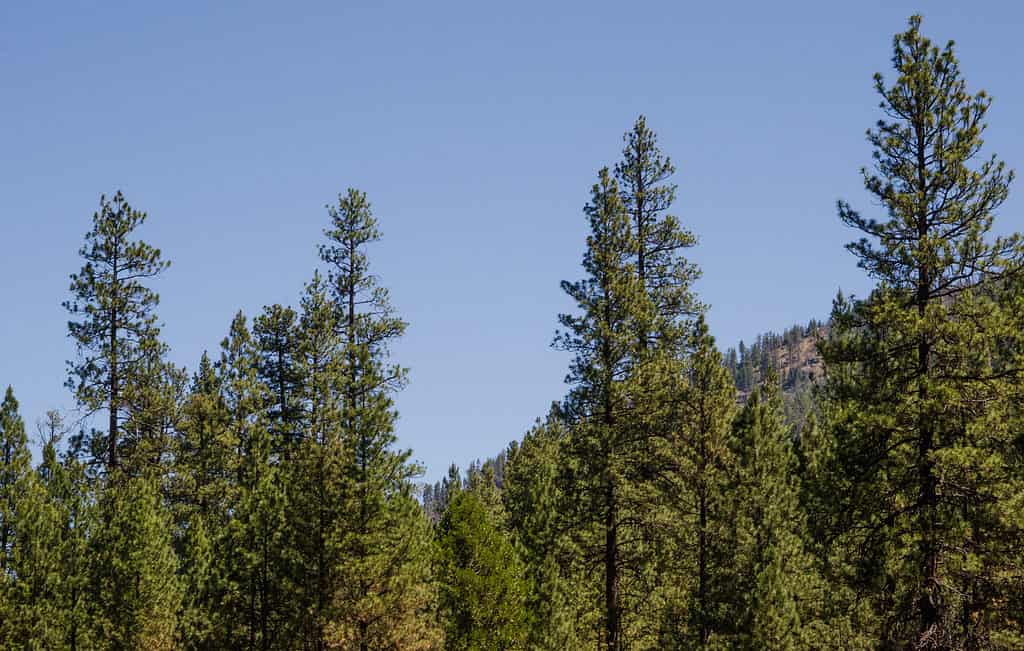
Ponderosa pine trees can grow over 200 feet tall.
©iStock.com/Rex_Wholster
Summary of 9 Animals That Lurk Atop Texas’s Tallest Mountain
| # | Common Name | Scientific Name |
|---|---|---|
| 1 | Elk | Cervus canadensis |
| 2 | Black Bear | Ursus americanus |
| 3 | Mountain Lion | Puma concolor |
| 4 | Gray Fox | Urocyon cinereoargenteus |
| 5 | Mule Deer | Odocoileus hemionus |
| 6 | Striped Skunk | Mephitis mephitis |
| 7 | Hog-Nosed Skunk | Conepatus |
| 8 | Mountain Short-Horned Lizard | Phrynosoma hernandesi |
| 9 | Porcupine | Erethizon dorsatum |
Thank you for reading! Have some feedback for us? Contact the AZ Animals editorial team.

